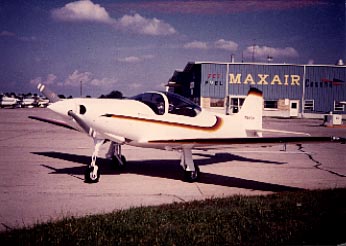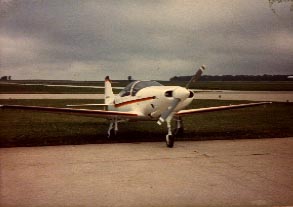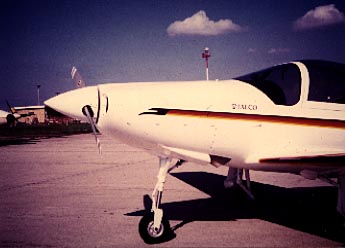El Supremo:
The Sequoia Falco
![]()
El Supremo:
|
|
by Jim Campbell
|
This article appeared in the Summer 1985 Sport Pilot. |
There is an increasing market among the homebuilt community for aircraft with phenomental performance, handling, style and looks. Airplanes that fit this description do indeed exist and are far more prevalent these days than they were just a few short years before. People interested in the aforementioned specs though, are going to find that such qualities are not free and don't even come close to being cheap. Surprisingly, those in this select group are more than willing to pay the price of admission to this exclusive club. They are obviously in search of an aircraft that can be acquired no other way.
Sequoia Aircraft's Falco may be the quintessential example of the high performance kit plane. Based on an Italian aircraft that was once produced into over a hundred flying renditions, the Falco kit is presently the only way to get a new version of this superbird.

If there is a driving force behind this aircraft's continued viability as a commercial entity, it is Alfred Scott, the heart of Sequoia Aircraft. The amount of work that he has done to kit and market this aircraft borders on fanaticism. Not a single part has gone without excessive documentation and testing. Nothing is static, he is always improving, honing, simplifying and just plain babying this design to someday reach some unheard of level of perfection that will no doubt cause the Falco to be the first choice among many builders.
The Falco is the design of Stelio Frati. Frati is one of those prolific designers that seemed to be interested in a little bit of everything since his works covered a wide aeronautical spectrum. The first of the Falco series was actually a 90 horsepower design that first spread its wings in 1955. The first of the production ships was powered by a 135 hp Lycoming which saw further upgrades to a 150 and then 160 horse engine and a constant speed prop. Over one hundred examples of the Falco were produced by several different European manufacturers. Frati was also the inspired genius behind another European hot rod that was eventually produced by SIAI Marchetti-the SF.260.
The kit built Falco is a two-seat aircraft that has been clocked at speeds as high as 230 mph on only 160 horsepower. A low winged retractable with aerobatic capability, the Falco fits a gap that has here-to-fore been largely unfilled in the aeronautic marketplace. With the installation of the Lycoming O-320-B3B, the Falco boasts a useful load of 668 pounds, a climb rate of 1140 feet per minute and a cruise speed of 190 miles per hour.
When Alfred Scott opened negotiations to obtain plans for the Falco, I doubt that he realized what kind of effort he would be undertaking. It didn't take too long before he found himself in full fledged kit development of an aircraft that boasted some smooth and complex flowing lines-the kind that sport a lot of curves and other homebuilding nightmares. Be that as it may, Scott sought to produce a kit of the highest quality, along the lines of the Christen Eagle-a kit well known for its outstanding quality and attention to detail.
In the process of turning the production Falco into a kit-plane, Scott chose to make a few changes here and there in order to increase the performance, utility, comfort and ease the possibility of construction difficulties. Many of the performance and cosmetic changes were suggested by the owner of an Italian production Falco that had seen quite a bit of custom "fiddlin' and tweakin'." Luciano Nustrini's Falco is probably the most advanced example of this series. The superb modifications that this ship has undergone are a big part of what eventually allowed it to win the 1981 Giro d'Italia race with an average speed of 234 mph! This is not a typographical error gang, Nustrini's super Falco has been clocked at over 240 mph. The success of this particular machine was the spearhead for much of the improvements in the Sequoia aircraft kit.
The performance and utility of the Falco was enhanced by increasing the fuel capacity to 40 gallons in order to get a range in excess of 1000 miles. A small two-gallon header tank allows for a reasonable amount of inverted time if that kind of thing turns you on. An optional 180 horsepower installation is now available for the "I want to go VERY fast" crowd while modifications to the exhaust system have allowed for far greater efficiency, as has the new spinner/cowling design, an improved engine induction system and many other assorted details.
Scott was particularly active in the area of the cockpit. He engineered the installation of a 40 G seat belt system- just about the limit of human endurance and the first of this type to be offered in a general avaiation type aircraft. Other interior changes included the redesign of the seats, more headroom, some weight shaving, and a more aesthetic appearance. Improvements in cabin ventilation have been joined with similar changes to the heating system.
Scott has put together a dream of an IFR panel that just begs to go places-fast! Removable in as little as ten minutes, this panel can handle more avionics than you can imagine in one easy maintenance and installation due to a simply engineered and color coded wiring harness. The windshield and canopy are the semi-polarized "solar-grey" type of plexiglass; a defrosting system is available to keep things inside the cockpit somewhat VFR.
Apparently one of the few complaints to be made about the early Falco production ships had to do with a large amount of interior noise present while in flight. Sequoia has done their homework in this area by utilizing, quarter-inch glass for the windshield, dynafocal engine mounts, the NACA submerged duct style cabin air inlet, a quieter exhaust system, and improvements in both insulation and the sealing between the cabin and engine area.
Since the average homebuilder is usually involved in such a project in order to get the exact airplane that he/she always wanted, the staff of Sequoia continued their winning ways with the advent and availability of many other changes to the basic Falco. One of the most popular options is the rakish canopy that first appeared on Nustrini's Falco. Inverted fuel tanks, differential brakes, a removable right seat control stick, throttle quadrant, and a left hand throttle also appeared as part of the Falco's multitalented nature. Scott was very active in seeing that the Falco could be just what everyone wanted and prefereed to make the necessary modifications himself than to allow the possibility of substandard mods by anxious kitbuilders. The electrical system boasts a great deal of room for growth while the fire wall already has provisions to accept a smoke system. Now . . . if that isn't adaptability, what is?
The most intensive part of designing the kit probably came in adapting the machine to suit the construction capabilities of the average homebuilder. This process was complicated by the fact that Scott decided to design a very complete kit and not leave any guesswork on such things as ancillary systems during the last 10 to 20 percent of the construction producess (as some manufacturers have chosen to do). The Sequoia Falco received extensive redesign in the area of the fire wall, pitot-static system, electrical system (Scott boasts over 3000 hours of design work in this area alone), vacuum system, fuel system, exhaust system and several others.

Powerwise, Sequoia Aircraft has approved three powerplants for installation in the kit. The standard choice for a Falco engine seems to be the Lycoming I0-320-B1A. Offering 160 ponies of get up and go, this engine uses a constant speed prop and is also suitable for inverted shenanigans. Many of these engines saw service on such aircraft as the twin Comanche and should be widely available on the used market.
The 150 horsepower, low compression Lycoming I0-320-A1A cannot only be operated on lower octaine fuels but seems to slurp up autogas with nary a hiccup. The use of this engine coupled with the speedy performance of the Falco would seem to indicate that operating costs could be kept to a very reasonable level.
The 180 horse I0-360-B1E is also approved for installation ont he Falco and is the biggest engine that the factory endorses. Alfred Scott expects that this engine will yield at least four percent more in the speed department with some similarly gratifying improvement in takeoff and climb figures. It's original claim to frame was being the standard powerplant on Piper's Arrow; they are in plentiful supply and utilize a constant speed prop and allow for the possibility of inverted flight. Scott tends to downplay the use of the larger engine since its higher fuel consumption cuts into the range. Besides this, the normal operating practices of most pilots seem to tend toward the smoothest operating power settings; a tendency that will negate much of the possible speed increases.
The use of other engines is possible but the builder is definitely going to be on his or her own. Engine control cables as well as other important engine support systems just will not be available for any other engines. Sequoia does its best to keep its builders from striking out on their own, and they feel that an engine change is not a very good idea for most builders.
The Falco is very much a wooden wonder. Building one of these speedy little birds is a process that is spaced over a series of 23 magnificently complete sub-assembly kits. Each kit is accompanied by a set of what has to be one of the most detailed sets of drawings that this writer has ever seen. The plane alone consists of over 300 sheets of large blueprints or smaller printed sheets. Since all of the measurements are done in metric values, it makes sense to pick up a metric ruler or two and learn to use the little critters. The detail on these documents is extremely impressive and will soon be joined by a very comprehensive construction manual to aid those with little experience in this type of work. All in all, the plans total up to over 790 square feel of area-that's a lot of information!
Building a Falco has been described by many as an involved process that will require many thousands of hours to complete. This is unquestionably true for the present but may not be that way for much longer. There is a great deal of work being done over at Sequoia to bring the relative complexity and the subsequent building times well below a total of 1500 hours.
The wood working portion of construction is easily the most time-consuming part of the assembly. Scott estimated that 90 percent of the work required to build a Falco is wood work. He further broke this wordworking down to three basic types of tasks. The first is to fit two pieces of wood together, aligning them carefully and then gluing them to each other with the use of sufficient clamp pressure. This is the type of operation that might be used to install a wing rib on the spar. The second operation is most typically the installation of a kit part in the proper position, drilling a hole in the corresponding structure that matches the hole already drilled in the original part and then installing the proper bolt, washer and nut. This is done on things like the control hinges in order to fix them to the appropriate control surfaces. The final one of these basic steps is notorious among those who have even the slightest experience with wood-sanding. Sanding is a big part of what must be done to the ribs, spars, and fuselage frames so that the skin will lie flat over them.
Obviously, there will be more to building this aircraft than these three steps but they do form a nucleus for what must be done to finish one of these aircraft. Scott feels that if you have the ability to handle these three basic items, then you have the ability to build a Falco. Surprisingly, prior building experience hardly seems to be as big an advantage as one would imagine. Scott feels that strict attention to the plans is the fastest and surest way to build a Falco and that many experienced builders are a bit too anxious to make changes Many of these experience builders have run into all kinds of roadblocks while trying to piece their bird together.

As mentioned previously, Sequoia has made significant progress in the past year or two toward the goal of a substantially lesser builder time. Items like wing jigging have received enough attention to allow the time required for this step to be cut in half. Other items like wing fillets and canopy skirt fairings have been known to take in excess of 100 hours apiece to complete. New assemblies have simplified these items immensely. At this point, the current estimations indicate that the Falco could require as little as 1200 to 1500 hours to complete.
The use of a new construction manual (which is now being written) to augment the plan set should eliminate much of the time that otherwise might be spent in anxious contemplation of what should be done next. The use of this manual in addition to the ongoing efforts to improve kit simplication and prefabrication should eventually bring the Falco down to a building time of between 800 and 1200 hours.
Alfred Scott suggests a few steps that might be taken to help the builder shorten his building times dramatically. He first asserts that each builder should follow the plans and not go galavanting around with changes. He further suggests that it makes sense to buy some of the kits a bit on the early side so that some of their parts can be checked against the other completed portions of the aircraft. Do call Sequoia as often as it necessary, they are more than happy to answer any and all questions that may come up. Adequate tools and shop space are a must. Poor working space and improper tools will slow the process down dramatically. Pacing yourself carefully and developing a proper working schedule will keep the project from bogging down unnecessarily. The last point that he makes is to spend as much time as you need thinking about what you are doing before actually starting work on any particular step.
As you can guess, the Falco is hardly an "instant" airplane kit. If you want one of these aircraft, it is going to cost you a significant amount of time and money. The big question raised by all of these meanderings is: Is it worth it?
In an attempt to find an answer, I went flying for a little while in Scott's production Falco. His Falco was obviously in need of a bit of a facelift so I prepared myself to not expect too much from the aircraft. The short flight was a real eye-opener. The performance, handling, response and pizzazz of this aircraft is undeniable. The Falco is an aircraft that just begs to play and the dozen rolls that we did in addition to a variety of other maneuvers were as playful as any I have experienced in a cabin-equipped aircraft. The most remarkable thing about this aircraft is its wonderful handling. For an aircraft was was supposed to be a distant second to the kit built version, the Falco is one fine flying ship indeed.
The first flying rendition of a stock Falco that was completed from the kit flew last summer. David Aronson of Minnesota is the tired but lucky dog who beat every one of his other kitbuilders to the punch and got to fly his creation to airplanes lover's home away from home -- Oshkosh, Wisconsin. Dave's airplane will be flying down to Sun n' Fun '85 where this writer will be catching up with it for a full flight evaluation for the pages of Sport Pilot. What this space, 'cause the Falco will be coming... FAST!
|
|